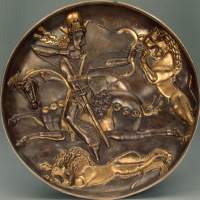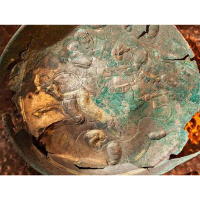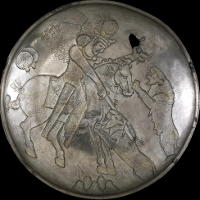A Sasanian Alabaster Disc with King Hunting Lions, 4th Century AD.
Cleveland Museum of Art 1963.258

A larger image of this Sasanian Alabaster Disc with King Hunting Lions, 4th Century AD. Cleveland Museum of Art 1963.258
Sasanian King Hunting Lions
late 300s CE
Iran, Sasanian Empire
(224–651 CE)
Alabaster
Diameter: 3.5 x 49.2 cm (1 3/8 x 19 3/8 in.)
Leonard C. Hanna, Jr. Fund 1963.258
Source: Cleveland Museum of Art
Relief Plaque with Royal Hunting Scene: Ardashir II (?) Hunting Lions. Alabaster. Iran, Sasanian Period, late 4th century. D. 49 cm. 63.258
Listed on p.6 Handbook : the Cleveland Museum of Art, 1978.
Introduction
Based on the identified kings on the plates of the Sassanid period, we know that since Bahram I, making plates with the role of the Sassanid kings has become common and the largest number belongs to Shapur II and Bahram V (Akbari, 2020: 186).
Studies show that most Sassanid plates represent the royal hunting scene;
However, plates with the display of the crown scene, feasts, family scenes as well as single and legendary animals have also been represented (Vosough Babaei and Mehrafarin, 2015).
The prevalence of plate-making at the same time as the decline in relief-making suggests that perhaps plate-making is in some way significantly related to the diminishing importance of reliefs.
Certainly, the Sassanid kings replaced the plates with reliefs for reasons that are not clear.
The advantages of plates seem to be cheaper, require less manufacturing time and are portable.
According to the fact that these plates have been discovered in lands far from the center of the empire, on the southern shores of the Caspian Sea, Central Asia, and the former Soviet Union and more recently in Afghanistan,
these objects may be a means of propaganda and displaying the power and legitimacy of the Sassanid kings (Gireshman, 2012: 203; Orbeli, 2009; Seyed Aliyev, 2013).
Although most Sassanid plates are made of gold and silver, a different piece has been reported;
this piece is a marble disc that has been registered in the Cleveland Museum of Art with the number D. 1963.258 (Handbook of the Cleveland Museum of art.1969: 13) (Fig.1),
It is the subject of this research.
About depicted person on the disc, according to Dorothy Shepard, he is Ardeshir II.
Due to the unusual form and uniqueness of such an object among the Sassanid works and considering that the subject engraved on it is characteristic of the art of the Sassanid period;
But with the help of archaeological data, interesting information can be provided.
The objectives of this study are to understand the person engraved on this marble disk and to try to evaluate the claim that the person engraved is Ardeshir II of Sassanid?
In addition, the authors try to evaluate the origin of the marble disk based on archaeological findings so that they can speculate about the geographical area of production of this object and determine whether this work is the product of the area from which it was found.
Or was it produced elsewhere in the realm of the Sassanid kingdom?
There is not much reliable information about the location of this disc.
According to reports, this work was apparently found in 1954 along with a silver plate with a very similar scene by a brick factory worker near the Sari railway (Sami 2010, vol. 2: 120; Vandenberg, 1970: 7) (Fig.2).
The silver plate, unlike the marble disc in the Cleveland Museum, is kept in the National Museum of Iran.
The person depicted in both works is undoubtedly one person; this assurance is due to the accurate repetition of the crown, details of the face, costume and scene.
The plate is made of marble and the engraved king has been introduced as Ardeshir II (Shepard, 1983).
Shepard’s reason for the attribution was the similarity between the plate crown and the relief of Ardeshir II at Tagh-e Bostan.
Considering the kings on plates with very similar scene, namely Hormozd II and Shapur II, respectively, it is possible that the marble disk also belongs to the same period.
The Bronze Age stone disk on which the Sassanid motif is engraved has probably been obtained from its original context for some reason and has been given to the artist of the Sassanid period.
But why and how this object was used to create such a role is unclear.
Bronze Age stone disks were not used during the Sassanid period, or at least were not so similar.
It is therefore clear that the specimen is evidence of unearthing of a Bronze Age object in a Sasanid period.
The Cleveland Museum’s Sassanid/Bronze Age disc is definitely inspired by the Bronze Age culture of the region.
This example proves that many of the silver artifacts found from Mazandaran are actually made in the region and were not because of treasures sent to Mazandaran at the time of Sasanian collapse.
In addition to the disk and the abundance of silver works found in Mazandaran, another evidence that supports this claim is the inscribed specimens with the names of Espahbodan and the elites of Mazandaran on some specimens.
At the same time, it should be borne in mind that probably not all Sassanid plates in the royal workshops of the Sassanid are produced in the hinterland, but also in areas far from these centers.
Due to the shape of Ardeshir's crown, which is engraved at Tagh-e Bostan with good quality and clarity, as well as his coins, is different to the rider's crown on the marble disc of the Cleveland Museum of Art, the difference is in decoration and form.
The Crown has two spherical protrusions.
It is engraved on the king's forehead and has a crescent on top, so it cannot belong to Ardeshir II.
The final point is that the role of the Sassanid disk crown and plate under study has not been reported in any reliefs or coins.
Hence, the person in the scene is the crown prince or prince who rules in Mazandaran and the northern and northeastern regions,
but has never ascended to the throne or changed his crown after it.
The influential kings in the history of the region are: Bahram I, Firuz I, Bahram V, Ghobad and his son Kyus.
Among them, Firuz I, Bahram-V and Ghobad never ruled Mazandaran or related regions and entered the region only after being crowned.
Bahram I and Kyus were both princes and crown princes and ruled the northern regions of Iran.
The shape of Bahram's crown is unknown before his reign, and Kyus was killed before the reign during a campaign to gain the monarchy against his brother;
however, his descendants always maintained their power in the region.
If we consider the person engraved on the Sassanid disk and plate as a member of the Sassanid royal family in the Mazandaran region, this person will most likely be Bahram I or Kyus.
But if we consider this person as one of the ruling families of Tabarestan at the beginning of Islam, who were often completely loyal to the customs and traditions of the Sassanids, it will be very difficult to identify him;
Because the local kings of Tabarestan minted coins in Sassanid kings motif, and the image of the local kings was not used on the coins;
As a result, it is not possible to identify them at present and we will have to wait for future archaeological findings.
In addition, it should be noted that this plate and disk is more in the style of the royal plates of the Sassanid period than it is similar to the samples of the Islamic period or the copies modeled on the Sassanid samples.
As a result, it is unlikely to belong to local families, although it is not impossible.

Figure 2: Sasanid silver plate with lion hunting scene

Figure 3: A plate of Shapur II, lion hunting, Hermitage Museum, Russia

Figure 4: Plate with the scene of Hormozd II hunting a lion, Cleveland Museum of Art

Figure 5: The scene of Ardashir II while hunting lions, Mes Aynak, Afghanistan

Figure 6: Sasanid plate with the scene of Bahram Gore hunting two lions; British Museum
Figure 9: Ardashir II (middle person) at Tagh-e Bostan

Figure 12: Sample from Altin Teppeh Bronze Age Discs
Source: "Notes on the Sasanian Alabaster Disc in the Cleveland Museum of Art", Parastoo Masjedi Khak, Mostafa Khazaei Kouhpar (215-232) Journal of Archaeological Studies No. 4, Vol. 13, Serial No. 28 / Winter 2022
Back to Figures on Sasanian and Central Asian Plates







